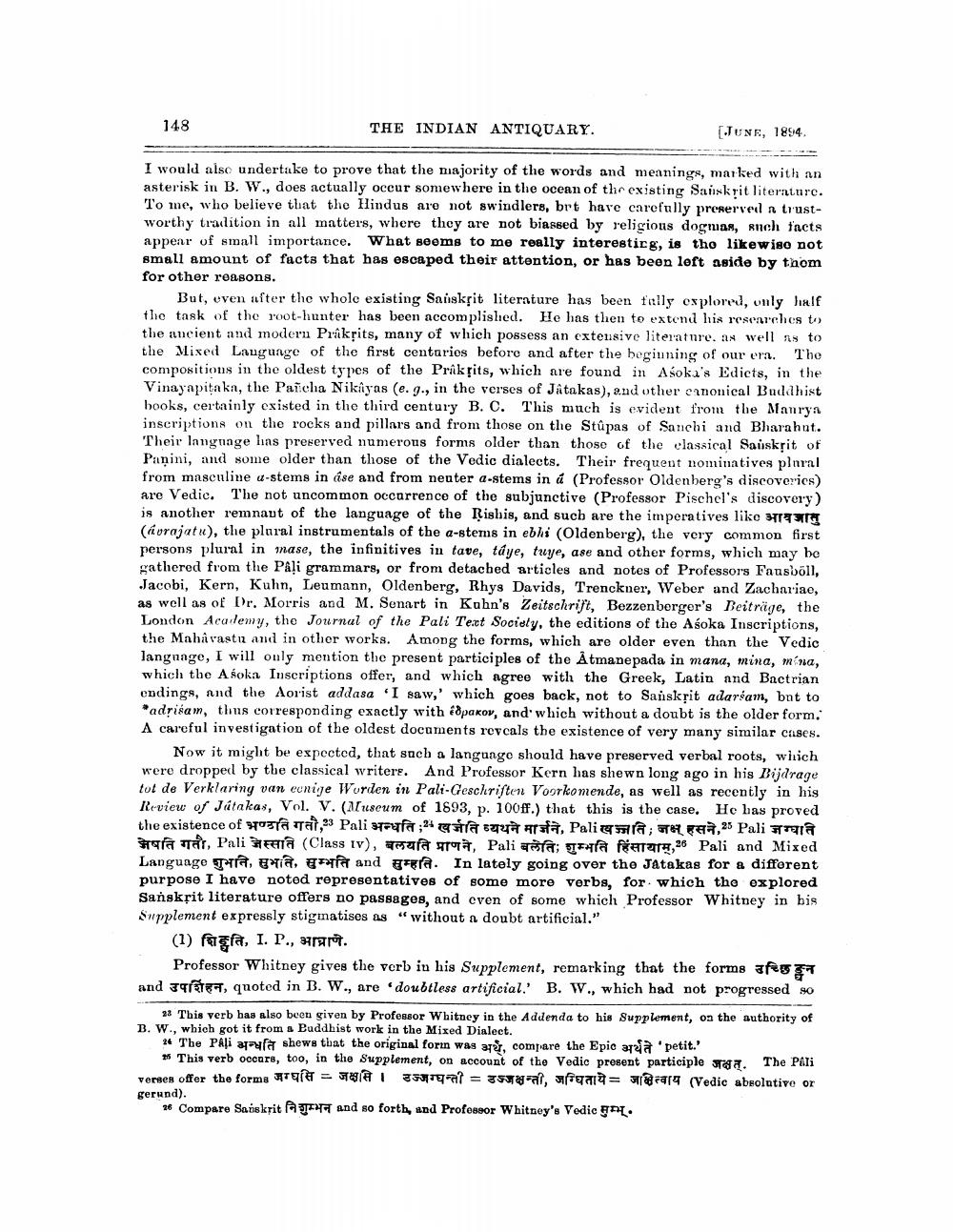________________
148
THE INDIAN ANTIQUARY.
[JUNE, 1894
I would also undertake to prove that the majority of the words and meanings, marked with an asterisk in B. W., does actually occur somewhere in the ocean of the existing Sanskrit literature. To me, who believe that the Hindus are not swindlers, brt hare carefully prererved n trustworthy tradition in all matters, where they are not biassed by religious dogmas, such facts appear of small importance. What seems to me really interesticg, is tho likewiso not small amount of facts that has escaped their attention, or has been left aside by thom for other reasons.
But, even after the whole existing Sanskrit literature has been fully explored, only half the task of the root-hunter has been accomplished. He has then to extend his researches to the ancient and modern Prakrits, many of which possess an extensive literature, as well as to the Mixed Laugunge of the first centuries before and after the beginning of our era. The compositions in the oldest types of the Prakrits, which are found in Asoka's Edicts, in the Vinayapitaka, the Pancha Nikayas (e.g., in the verses of Jatakas), and other canonical Buddhist books, certainly existed in the third century B. C. This much is evident from the Manrya inscriptions on the rocks and pillars and from those on the Stupas of Sanchi and Bharahnt. Their langnage las preserved numerous forms older than those of the classical Sauskpit of Panini, and some older than those of the Vedic dialects. Their frequent nominatives plural from masculine u-stems in ase and from neuter a-stems in á (Professor Oldenberg's discoveries) are Vedic. The not uncommon occurrence of the subjunctive (Professor Pischel's discovery) is another remnant of the language of the Rishis, and such are the imperatives like 317 (a vrajatu), the plural instrumentals of the a-stems in ebhi (Oldenberg), the very common first persons plural in mase, the infinitives in tave, táye, tuye, ase and other forms, which may be gathered from the Pâli grammars, or from detached articles and notes of Professors Fausboll, Jacobi, Kern, Kuhn, Leumann, Oldenberg, Rhys Davids, Trenckner, Weber and Zachariae, as well as of Dr. Morris and M. Senart in Kohn's Zeitschrift, Bezzenberger's Beiträge, the London Academy, the Journal of the Pali Tect Society, the editions of the Asoka Inscriptions, the Maharastu and in other works. Among the forms, which are older even than the Vedic language, I will only mention the present participles of the Atmanepada in mana, mina, mina, which the Asoka Inscriptions offer, and which agree with the Greek, Latin and Bactrian endings, and the Aorist addasa "I saw,' which goes back, not to Sanskrit adarsam, bnt to *adrićam, thus corresponding exactly with ipakov, and which without a doubt is the older form. A careful investigation of the oldest documents reveals the existence of very many similar cases.
Now it might be expected, that such a language should have preserved verbal roots, which were dropped by the classical writers. And Professor Kern has shewn long ago in his Bijdrage tot de Verklaring van enige Wurden in Pali-Geschriften Voorkomende, as well as recently in his Review of Játakas, Vol. V. (A[useum of 1693, p. 100ff.) that this is the case. He has proved the existence of yozta Tai,23 Pali surat2 masya Atala, Palics , #,25 Pali mi ओषति गती, Pali जेस्सति (Class Iv), बलयति प्राणने, Pali बलेतिः शुम्भति हिंसायाम,26 Pali and Mixed Language शुभति, सुभति, सुम्भति and सुम्हति. In lately going over the Jatakas for a different purpose I have notod representatives of some more verbs, for which the explored Sanskřit literature offers no passages, and cven of some which Professor Whitney in his Supplement expressly stiginatises as “without a doubt artificial."
(1) fazla, I. P., Han.
Professor Whitney gives the verb in his Supplement, remarking that the forms are and Jare, quoted in B. W., are doubtless artificial.' B. W., which had not progressed 90
28 This verb bas also been given by Professor Whitney in the Addenda to his Supplement, on the authority of B. W., which got it from a Buddhist work in the Mixed Dialect.
24 The PAli ya shews that the original forin was 3, compare the Epic a a 'petit.'
15 This verb occars, too, in the Supplement, on account of the Vedic present participle ea. The Pali verden offer the forme Age = @ 3 a = zsal, afegid= care (Vedic absolutive or gerund).
* Compare Sanskrit Pay and so forth, and Professor Whitney's Vedic St.




